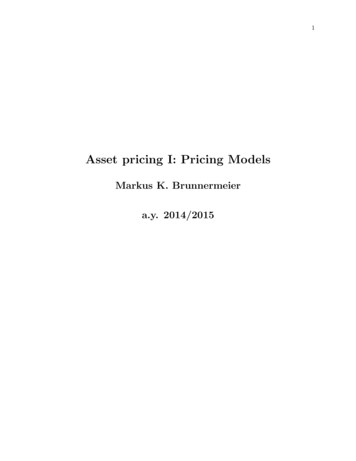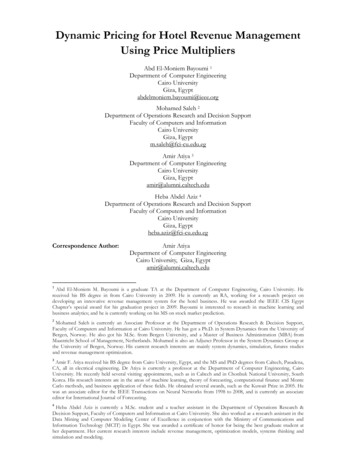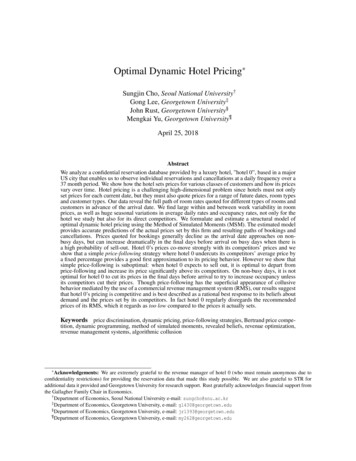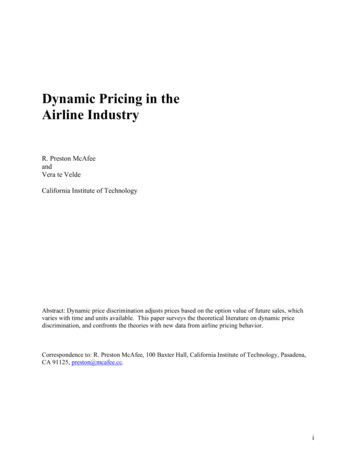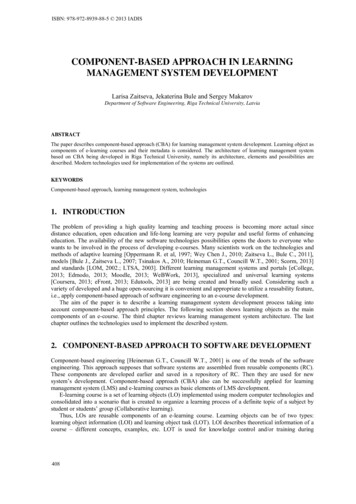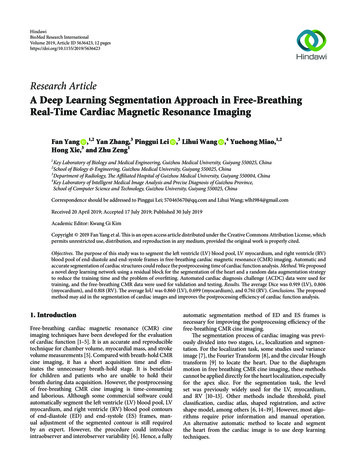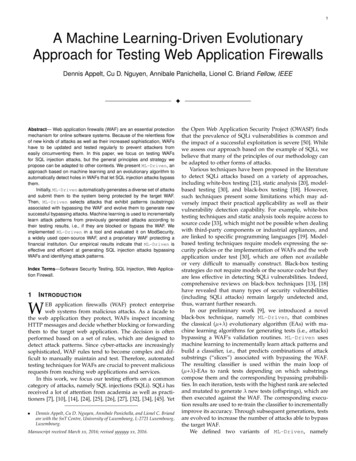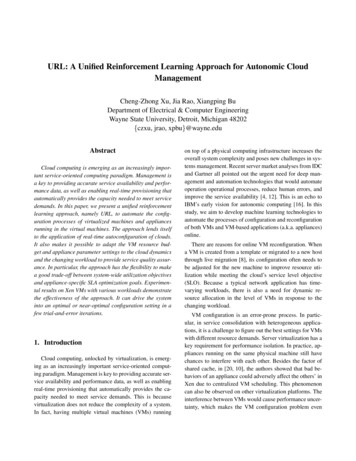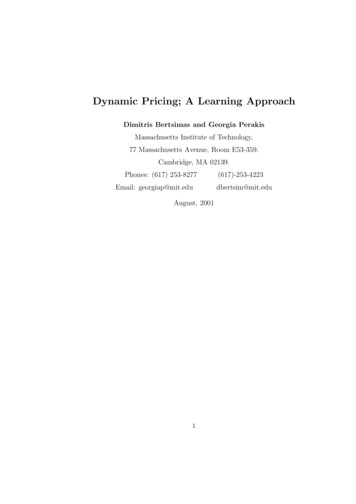
Transcription
Dynamic Pricing; A Learning ApproachDimitris Bertsimas and Georgia PerakisMassachusetts Institute of Technology,77 Massachusetts Avenue, Room E53-359.Cambridge, MA 02139.Phones: (617) 253-8277Email: georgiap@mit.eduAugust, 20011(617)-253-4223dbertsim@mit.edu
Dynamic Pricing; A Learning ApproachAbstractWe present an optimization approach for jointly learning the demand as a functionof price, and dynamically setting prices of products in an oligopoly environment in orderto maximize expected revenue. The models we consider do not assume that the demandas a function of price is known in advance, but rather assume parametric families ofdemand functions that are learned over time. We first consider the noncompetitivecase and present dynamic programming algorithms of increasing computational intensity with incomplete state information for jointly estimating the demand and settingprices as time evolves. Our computational results suggest that dynamic programmingbased methods outperform myopic policies often significantly. We then extend our analysis in a competitive environment with two firms. We introduce a more sophisticatedmodel of demand learning, in which the price elasticities are slowly varying functionsof time, and allows for increased flexibility in the modeling of the demand. We propose methods based on optimization for jointly estimating the Firm’s own demand, itscompetitor’s demand, and setting prices. In preliminary computational work, we foundthat optimization based pricing methods offer increased expected revenue for a firmindependently of the policy the competitor firm is following.2
1IntroductionIn this paper we study pricing mechanisms for firms competing for the same products ina dynamic environment. Pricing theory has been extensively studied by researchers froma variety of fields over the years. These fields include, among others, economics (see forexample, [36]), marketing (see for example, [25]), revenue management (see for example,[27]) and telecommunications (see for example, [21], [22], [29], [32], [33]). In recent years,the rapid development of information technology, the Internet and E-commerce has hadvery strong influence on the development of pricing and revenue management.The overall goal of this paper is to address the problem of setting prices for a firm inboth noncompetitive and competitive environments, in which the demand as a function ofprice is not known, but is learned over time. A firm produces a number of products whichrequire (and compete for in the competitive case) scarce resources. The products must bepriced dynamically over a finite time horizon, and sold to the appropriate demand. Ourresearch (contrasted with traditional revenue management) considers pricing decisions, andtakes capacity as given.Problem CharacteristicsThe pricing problem we will focus on in this paper has a number of characteristics:(a) The demand as a function of price is unknown a priori and is learned over time. Asa result, part of the model we develop in this paper deals with learning the demandas the firm acquires more information over time. That is, we exploit the fact thatover time firms are able to acquire knowledge regarding demand behavior that can beutilized to improve profitability. Much of the current research does not consider thisaspect but rather considers demand to be an exogenous stochastic process following acertain distribution. See [7], [8], [10], [11], [16], [17], [19], [29].(b) Products are priced dynamically over a finite time horizon. This is an important aspectsince the demand and the data of the problem evolve dynamically. There exists a greatdeal of research that does not consider the dynamic and the competitive aspects of3
the pricing problem jointly. An exception to this involves some work that appliesdifferential game theory (see [1], [2], [9]).(c) We explicitly allow competition in an oligopolistic market, that is, a market characterized by a few firms on the supply side, and a large number of buyers on the demandside. A key feature of such a market (in contrast to a monopoly) is that the profit onefirm receives depends not just on the prices it sets, but also on the prices set by thecompeting firms. That is, there is no perfect competition in an oligopolistic marketsince decisions made by all the firms in the market impact the profits received by eachfirm. One can consider a cooperative oligopoly (where firms collude) or a noncooperative oligopoly. In this paper we focus on the latter. The theory of oligopoly datesback to the work of Augustin Cournot [12], [13], [14].(d) We consider products that are perishable, that is, there is a finite horizon to sellthe products, after which any unused capacity is lost. Moreover, the marginal costof an extra unit of demand is relatively small. For this reason, our models in thispaper ignore the cost component in the decision-making process and refer to revenuemaximization rather than profit maximization.Application AreasThere are many markets where the framework we consider in this paper applies. Examples include airline ticket pricing. In this market the products the consumers demand, arethe origin-destination (O-D) pairs during a particular time window. The resources are theflight legs (more appropriately seats on a particular flight leg) which have limited capacity.There is a finite horizon to sell the products, after which any unused capacity is lost (perishable products). The airlines compete with one another for the product demand whichis of stochastic nature. Other industries sharing the same features include the service industry (for example, hotels, car rentals, and cruise-lines), the retail industry (for example,department stores) and finally, pricing in an e-commerce environment. All these industriesattempt to intelligently match capacity with demand via revenue management. A review4
of the huge literature in revenue management can be found in [27], [34] and [35].Contributions(a) We develop pricing mechanisms when there is incomplete demand information, byjointly setting prices and learning the firm’s demand without assuming any knowledgeof it in advance.(b) We introduce a model of demand learning, in which the price elasticities are slowlyvarying functions of time. This model allows for increased flexibility in the modelingof the demand. We propose methods based on optimization for jointly estimating theFirm’s own demand, its competitor’s demand, and setting prices.StructureThe remainder of this paper is organized as follows. In Section 2, we focus on the dynamicpricing problem in a non-competitive environment. We consider jointly the problem ofdemand estimation and pricing using ideas from dynamic programming with incompletestate information. We present an exact algorithm as well as several heuristic algorithmsthat are easy to implement and discuss the various resulting pricing policies. In Section 3,we extend our previous model to also incorporate the aspect of competition. We proposean optimization approach to perform the firm’s own demand estimation, its competitor’sprice prediction and finally its own price setting. Finally, in Section 4, we conclude withconclusions and open questions.2Pricing in a Noncompetitive EnvironmentIn this section we consider the dynamic pricing problem in a non-competitive environment.We focus on a market with a single product and a single firm with overall capacity c overa time horizon T . In the beginning of each period t, the firm knows the previous price anddemand realizations, that is, d1 , . . . , dt 1 and p1 , . . . , pt 1 . This is the data available to the5
firm. In this section, we assume that the firm’s true demand is an unknown linear functionof the formdt β 0 β 1 pt t ,that is, it depends on the current period prices pt , unknown parameters β 0 , β 1 and arandom noise t N (0, σ 2 ). The firm’s objectives are to estimate its demand dynamicallyand set prices in order to maximize its total expected revenue. Let P [pmin , pmax ] be theset of feasible prices.This section is organized as follows. In Section 2.1 we present a demand estimationmodel. In Section 2.2, we consider the joint demand estimation and pricing problem througha dynamic programming formulation. Using ideas from dynamic programming with incomplete state information, we are able to reduce this dynamic programming formulation toan eight-dimensional one. Nevertheless, this formulation is still difficult to solve, and wepropose an approximation that allows us to further reduce the problem to a five dimensionaldynamic program. In Section 2.3 we separate the demand estimation from the pricing problem and consider several heuristic algorithms. In particular, we consider a one-dimensionaldynamic programming heuristic as well as a myopic policy heuristic. To gain intuition, wefind closed form solutions in the deterministic case. Finally, in Section 2.4 we consider someexamples and offer insights.2.1Demand EstimationAs we mentioned at time t the firm has observed the previous price and demand realizations,that is, d1 , . . . , dt 1 and p1 , . . . , pt 1 and assumes a linear demand model dt β 0 β 1 pt t ,with t N (0, σ 2 ). The parameters β 0 , β 1 and σ are unknown and are estimated as follows.We denote by xs [1, ps ] and by β s the vector of the parameter estimates at times, (β s0 , β s1 ). We estimate this vector of the demand parameters through the solution of theleast square problem,β t arg minr 2t 1 (ds x s r)2 ,s 16t 3, . . . , T.(1)
Proposition 1 : The least squares estimates (1) can be generated by the following iterativeprocess β t β t 1 H 1t 1 xt 1 dt 1 xt 1 βt 1 ,t 3, . . . , Twhere β 2 is an arbitrary vector, and the matrices Ht 1 are generated byHt 1 Ht 2 xt 1 x t 1 , 1with H1 p1t 3, . . . , T, t 1p1 . Therefore, Ht 1 p21t 1s 1ps t 1ps s 1t 1s 1p2s . Proof: The first order conditions of the least squares problem for β t and β t 1 respectively,imply thatt 1 ds x s β t xs 0s 1t 2 (2) ds x s β t 1 xs 0.(3)s 1If we write, β t β t 1 a, where a is some vector, it follows from (2) thatt 1 ds x s β t 1 x s a xs 0.s 1This in turn implies that,t 2 ds x s β t 1 x s a xs dt 1 x t 1 β t 1 x t 1 a xt 1 0.(4)s 1Subtracting (3) from (4) we obtain thatt 1 x s a xs dt 1 x t 1 β t 1 xt 1 .s 1 Therefore, a H 1t 1 xt 1 dt 1 xt 1 βt 1 , with Ht 1 t 1 s 1 (xs xs ) t 1 s 1t 1 t 1t 1s 17pss 1 ps p2s .
Given d1 , . . . , dt 1 and p1 , . . . , pt 1 , the least squares estimates are(t 1)β t1t 1 ps ds s 1t 1 (t 1)p2s s 1t 1 pst 1 t 1 dss 1s 1 2t 1β t0,s 1 t 1pst 1 ds β t1 s 1pst 1.s 1The matrix Ht 1 is singular, and hence not invertible, whentt 1 p2s t 1 s 1 2ps.(5)s 1Notice that the only solution to the above equality is p1 p2 · · · pt 1 . If the matrixHt 1 is nonsingular, then the inverse is t 1p2s s 1 t 1 2t 1 2 (t 1)ps ps s 1s 1 H 1t 1t 1 ps s 1 t 1 2 t 1(t 1)s 1p2s t 1ps t 1 2 (t 1)p2s ps s 1s 1 . t 1 2 t 1t 1s 1t 1(t 1)pss 1s 1p2s pss 1Therefore, t 1p2s s 1 t 1 2t 1 2 (t 1)ppss s 1s 1 x H 1t 1t 1 t 1 ps s 1 2 t 1t 1(t 1)s 1p2s pss 1 t 1 t 2psp2s pt 1 t 2ps s 1s 1 t 1 2 t 1 2 t 1 22 (t 1)(t 1)ps psp pss 1 s 1s 1s 1s 1 t 2 pt 1 (t 2)pt 1 ps t 1 s 1 22 t 1t 1t 1t 1s 1t 1(t 1)s 1p2s (t 1)pss 1s 1p2s pss 1As a result, we can express the estimates of the demand parameters in period t in terms ofearlier estimates as 0 βt β 1tt 2p2s pt 1 t 2ps s 1s 1 t 1 2t 1 2 (t 1)0p p ss βt 1 01s 1s 1 (dt 1 β t 1 β t 1 pt 1 ) t 2 1 (t 2)pt 1 psβt 1 s 1 2 t 1t 1 (t 1)s 18p2s pss 1 . .
The estimate for the variance σ at time t is given by t2 σ 2 0 β 1 pt 1 d β ττttt 3τ 1.Notice that the variance estimate is based on t 1 pieces of data, with two parametersalready estimated from the data, hence there are t 3 degrees of freedom. Such an estimateis unbiased (see [30]).2.2An Eight-Dimensional DP for Determining Pricing PoliciesThe difficulty in coming up with a general framework for dynamically determining pricesis that the parameters β 0 and β 1 of the true demand are not directly observable. What isobservable though are the realizations of demand and price in the previous periods, thatis, d1 , ., dt 1 and p1 , ., pt 1 . This seems to suggest that ideas from dynamic programming with incomplete state information may be useful (see [3]). As a first step in thisdirection, during the current period t, we consider a dynamic program with state space(d1 , ., dt 1 , p1 , ., pt 1 , ct ), control variable the current price pt and randomness comingfrom the noise t . We observe though that as time t increases, the dimension of the statespace becomes huge and therefore, solving this dynamic programming formulation is notpossible. In what follows we will illustrate that we can considerably reduce the high dimensionality of the state space. 0 , β 1 , s t, . . . , T, which is the currentFirst we introduce the notation, β s,t β s,ts,ttime t estimate of the parameters for future times s t, . . . , T . Notice that β t,t β t .Similarly to Proposition 1, we can update our least squares estimates through β t 1,t β t,t H 1t xt Dt xt βt,t . Notice that since in the beginning of period t demand dt is not t β 0 β 1 pt εt . As a result, vector β t 1,t is a randomknown, we replaced it with Dttvariable. A useful observation we need to make is that in order to calculate matrix Ht weneed to keep track of the quantitiest 1τ 1p2τ andt 1τ 1pτ . These will be as a result part of thestate space in the new dynamic programming formulation.It is natural to assume that the variance estimates change with time and do not remainconstant in future periods. This is the case since the estimate of the variance will be affected9
by the prices. That is, s2εs N 0, σs 1 τ 1 s2 σ dτ β s0 β s1 pτ 2,s 3s t, . . . , T.This observati
that optimization based pricing methods offer increased expected revenue for a firm independently of the policy the competitor firm is following. 2. 1 Introduction In this paper we study pricing mechanisms for firms competing for the same products in a dynamic environment. Pricing theory has been extensively studied by researchers from a variety of fields over the years. These fields .
